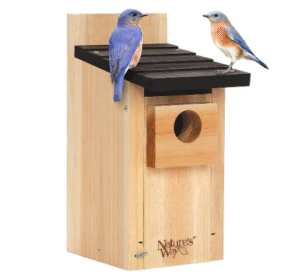🐦Birdhouse Reviews: Full Comparison
When you have decided to buy a birdhouse for your backyard,you must need to know which is the best.We’ve made birdhouse reviews and compared the top-rated birdhouses to create a cozy haven for your feathered friends. Read features, pros, cons, FAQs, and real customer insights!
1. Nature’s Way Bird Products CWH1 Cedar Wren House
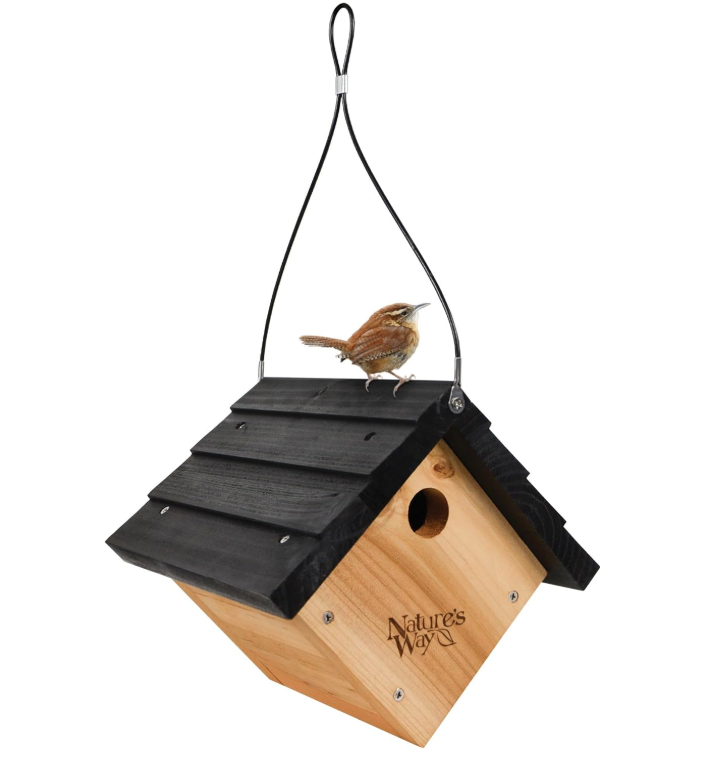
✨ Features:
- Made from naturally insect- and rot-resistant cedar wood
- Air vents for maximum airflow
- Clean-out door for easy maintenance
- Rust-free stainless steel hardware
✔️ Pros:
- Extremely durable and long-lasting
- Highly rated for attracting small birds like wrens and chickadees
- Natural look fits perfectly in gardens
❌ Cons:
- Too small for larger bird species
🌟 Customer Review:
“Built with high quality cedar! Perfect for wrens and chickadees!” – ⭐⭐⭐⭐⭐
❓ FAQs:
Q: Is this weatherproof?
A: Yes, cedar wood naturally resists moisture and decay.
Q: Is it easy to clean?
A: Yes, it has a built-in cleanout door!
2. Glitzhome 12″ Green Hanging Distressed Solid Wood Birdhouse
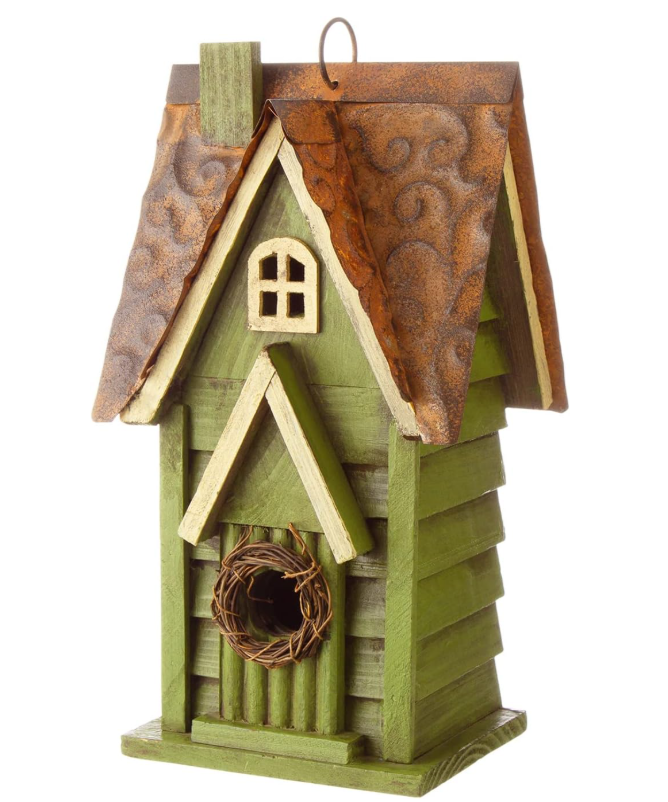
✨ Features:
- Handmade from natural wood and metal
- Rustic, vintage design
- Sturdy construction, perfect for garden décor
✔️ Pros:
- Elegant design for outdoor decoration
- Weather-resistant and durable
- Easy to install and hang
❌ Cons:
- May not attract many birds – more decorative
🌟 Customer Review:
“Lovely rustic vibe! Perfect accent for my garden.” – ⭐⭐⭐⭐⭐
❓ FAQs:
Q: Is it painted by hand?
A: Yes, each piece is handcrafted!
Q: Can it stay outside in the rain?
A: Absolutely, it’s built for outdoor conditions.
3. Nature’s Way CWH3 Cedar Bluebird Box House
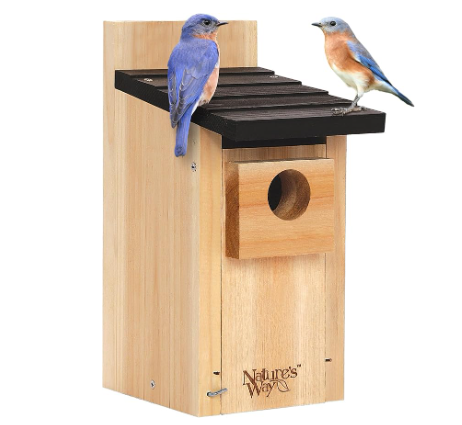
✨ Features:
- Predator guard included for added protection
- Easy open clean-out door
- Weather-resistant cedar and rust-free steel hardware
✔️ Pros:
- Specifically designed for bluebirds
- Highly protective design against predators
- Durable and weatherproof
❌ Cons:
- A little pricier than smaller birdhouses
🌟 Customer Review:
“Built tough! Bluebirds love it. A great investment!” – ⭐⭐⭐⭐⭐
❓ FAQs:
Q: Does it have proper drainage?
A: Yes, it includes drainage and ventilation holes.
4. Glitzhome 10.2″ Hanging Bird House Rustic Yellow Flower
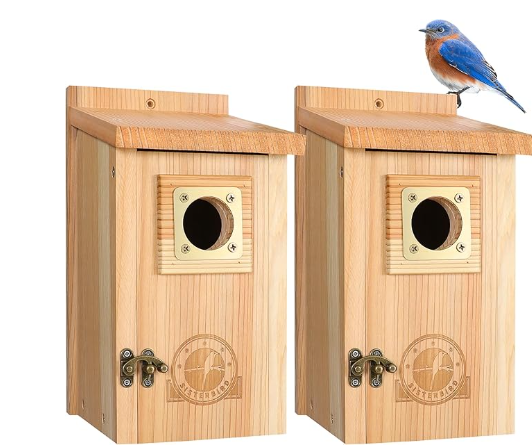
✨ Features:
- Hand-painted rustic finish
- Easy to install and clean
- Weather resistant and colorful
✔️ Pros:
- Bright and colorful design
- Durable for year-round use
- Affordable and well-crafted
❌ Cons:
- Primarily decorative (small entry hole)
🌟 Customer Review:
“Absolutely adorable and well-built! Great value for money.” – ⭐⭐⭐⭐⭐
❓ FAQs:
Q: Does it fade under sunlight?
A: Minimal fading thanks to weather-resistant paint.
5. 2-Pack Bird Houses with Copper Guard
✨ Features:
- Solid wood construction with copper guard
- Wide entrance for bluebirds and chickadees
- Rust-resistant galvanized screws included
✔️ Pros:
- Extra predator protection
- High-quality cedar wood material
- Pack of 2 – Great for larger backyards
❌ Cons:
- Assembly is needed (takes 10 minutes)
🌟 Customer Review:
“Great quality birdhouses! Easy to assemble and very sturdy.” – ⭐⭐⭐⭐⭐
❓ FAQs:
Q: Are screws provided?
A: Yes, mounting hardware is included!
Birdhouses by Bird Species
Different birds have different needs. Match the house to the species you want to attract:
| Species | Hole Size | Placement Height |
|---|---|---|
| Bluebirds | 1.5 inches | 4-6 feet |
| Chickadees | 1.125 inches | 6-15 feet |
| Wrens | 1 inch | 5-10 feet |
| Purple Martins | 2+ inches (colony houses) | 12-20 feet |
| Tree Swallows | 1.5 inches | 5-10 feet |
Materials: Wood vs. Plastic vs. Metal Birdhouses
Choosing the right material for your birdhouse is crucial for durability, safety, and bird comfort. Each material has its advantages and drawbacks—here’s a quick overview to help you decide which suits your needs best:
1. Wood Birdhouses
Pros:
- Natural Insulation: Wood provides excellent temperature regulation, keeping nests cooler in summer and warmer in winter.
- Aesthetically Pleasing: Blends well with natural surroundings, offering a rustic, traditional look.
- Breathability: Wood allows airflow, reducing moisture buildup inside the house.
- Easy to Modify: Wood is easy to drill, paint (with bird-safe paint), and customize.
Cons:
- Maintenance Required: Can rot, warp, or crack if not properly maintained or sealed.
- Pest Issues: Susceptible to mold and insects if moisture isn’t controlled.
- Heavier: Wood birdhouses can be heavier to mount.
2. Plastic Birdhouses
Pros:
- Durable and Weather-Resistant: Plastic resists rot, moisture, and insects well.
- Lightweight: Easy to hang or move around.
- Low Maintenance: Doesn’t need regular sealing or painting.
- Variety of Designs: Often comes in bright colors and varied shapes.
Cons:
- Poor Insulation: Plastic can get very hot in the sun, making nests uncomfortable or unsafe.
- Less Breathable: Can trap moisture, leading to mold or overheating.
- Less Natural Look: May stand out unnaturally in natural settings.
- Environmental Impact: Not biodegradable and may not be eco-friendly.
3. Metal Birdhouses
Pros:
- Extremely Durable: Resistant to weather, pests, and wear and tear.
- Modern Look: Can be sleek and stylish for contemporary gardens.
- Easy to Clean: Smooth surfaces make cleaning simpler.
Cons:
- Heat Conduction: Metal can become dangerously hot in direct sun, risking harm to birds.
- Noise: Can amplify sounds of rain or wind, potentially disturbing nesters.
- Weight and Installation: Heavier and harder to mount securely.
Which Material Is Best?
For most bird enthusiasts, wood remains the top choice due to its natural insulation, bird-friendly feel, and classic look. However, if you want something low maintenance and lightweight, plastic can be a practical option in shaded areas. Metal birdhouses are less common but work best in cooler climates or shaded spots where heat buildup won’t be a problem.
Always ensure whichever material you choose is non-toxic and safe for birds. Adding ventilation and drainage holes can help improve comfort, especially with plastic and metal birdhouses.
How to Place and Mount a Birdhouse
General Tips:
- Face the entrance away from prevailing winds.
- Mount securely on a pole or post (not a tree if possible — predators climb trees).
- Use a baffle to stop predators.
- Avoid busy human or pet areas.
Height and Placement:
| Bird Type | Mounting Height | Recommended Environment |
| Bluebird | 4-6 feet | Open grassy fields |
| Wren | 5-10 feet | Bushy gardens, woods |
| Chickadee | 6-15 feet | Woodland edges |
How to Attract Birds to Your Birdhouse
- Provide Nearby Water Sources: Birdbaths or small ponds.
- Use Native Plants: Trees and shrubs for cover.
- Add Bird Feeders: Suet, seeds, or mealworms.
- Avoid Bright Paints: Natural colors are best.
- Be Patient: Birds take time to scout and trust new houses.
DIY vs. Store-Bought Birdhouses: Which Is Right for You?
Choosing between building your own birdhouse or buying one off the shelf depends on your goals, budget, and how hands-on you want to be. Both options have their pros and cons—here’s a quick guide to help you decide:
DIY Birdhouses: The Personal Touch
Pros:
- Customization: You can tailor size, shape, materials, and entrance hole dimensions to attract specific bird species.
- Cost-Effective: Often cheaper if you have leftover wood or supplies at home.
- Creative Outlet: Building your own birdhouse can be a fun, rewarding project—great for families or hobbyists.
- Eco-Friendly Options: You control the materials and finishes, allowing for safer, more natural products.
Cons:
- Skill Required: Basic woodworking skills and tools are needed, which might be challenging for beginners.
- Time-Consuming: Design, cutting, assembly, and finishing can take hours or days.
- Potential Mistakes: Without experience, birdhouse design or construction errors can deter birds or cause durability issues.
Store-Bought Birdhouses: Convenience and Variety
Pros:
- Ready to Use: No assembly required—just hang it up and wait for birds to arrive.
- Wide Selection: Available in various sizes, materials, and designs for different bird species and aesthetics.
- Durability: Many are built with weather-resistant materials and tested designs.
- Tech-Enhanced Options: Some come with built-in cameras or smart features for birdwatching enthusiasts.
Cons:
- Cost: Quality birdhouses can be pricey, especially with special features.
- Less Customization: You might not find a perfect fit for your target species or preferred style.
- Unknown Materials: Some mass-produced birdhouses use treated wood or paints that may not be bird-friendly.
Which Should You Choose?
If you enjoy hands-on projects, want a unique birdhouse, and have some woodworking skills, a DIY birdhouse can be highly satisfying and effective. On the other hand, if convenience, guaranteed design, or advanced features like cameras are your priority, a store-bought birdhouse might be the better choice.
No matter which option you pick, the key is to ensure the birdhouse meets the needs of your local birds—safe, well-ventilated, and properly sized. When done right, both DIY and store-bought birdhouses can bring delightful bird visitors to your yard!
Maintenance Tips for Birdhouses
Keeping your birdhouse in good shape is essential for attracting birds year after year and providing a safe, comfortable nesting spot. Regular maintenance helps prevent disease, keeps pests away, and extends the life of your birdhouse. Here are some essential tips:
1. Clean Out Old Nests Annually
After the breeding season ends, remove old nests and debris to reduce parasites and disease. Use gloves and a mild bleach solution (1 part bleach to 9 parts water) to sanitize the interior, then rinse well and let it dry completely before rehanging.
2. Inspect for Damage and Repair
Check for cracks, loose nails, or broken panels. Replace or fix damaged parts promptly to keep the house sturdy and weatherproof. Ensure the entrance hole edges are smooth to avoid injuring birds.
3. Maintain Proper Ventilation and Drainage
Make sure ventilation holes near the top and drainage holes at the bottom aren’t blocked by debris or paint. Good airflow and drainage help keep the nest dry and comfortable.
4. Avoid Using Harmful Paints or Sealants
If repainting or sealing your birdhouse, use only non-toxic, water-based products safe for birds. Avoid painting the interior or entrance hole to keep it safe and inviting.
5. Protect from Predators
Regularly check and maintain any predator guards or baffles to keep cats, raccoons, and snakes away from the nest.
6. Repaint or Refinish as Needed
To protect wooden birdhouses from weather damage, apply a fresh coat of non-toxic, bird-safe paint or sealant every couple of years—but only on the exterior surfaces.
7. Avoid Disturbing Active Nests
Never open or clean a birdhouse during the nesting season to avoid stressing or abandoning the birds.
By following these maintenance tips, you’ll keep your birdhouse safe, clean, and attractive, ensuring a happy home for your feathered visitors for many seasons to come.
Frequently Asked Questions (FAQ) About Birdhouses
Q1: When is the best time to put up a birdhouse?
A: The ideal time is late winter or early spring—before birds begin nesting. This allows them to get used to the birdhouse without disturbance.
Q2: How high should I hang a birdhouse?
A: It depends on the species, but generally, 5 to 10 feet off the ground works well for many backyard birds. Research local species for specific height preferences.
Q3: How do I keep predators away from my birdhouse?
A: Use predator guards or baffles on poles, place the birdhouse away from low branches, and avoid easily accessible spots for cats and raccoons.
Q4: How often should I clean my birdhouse?
A: Clean your birdhouse annually after the nesting season ends. Remove old nests and sanitize to prevent parasites and disease.
Q5: Can I use a birdhouse with a camera without disturbing the birds?
A: Yes! Install the camera before nesting season and rely on remote monitoring to avoid disturbing birds during nesting.
Q6: What size entrance hole should my birdhouse have?
A: Entrance hole size varies by bird species. For example, chickadees prefer about 1 1/8 inches, while bluebirds need about 1.5 inches. Check local bird species preferences.
Q7: Can I paint or seal my birdhouse?
A: Yes, but only use non-toxic, water-based paints or sealants on the exterior. Avoid painting the inside or the entrance hole.
Q8: Why aren’t birds using my birdhouse?
A: Common reasons include poor placement, wrong size, predators nearby, or the house not being clean or safe. Adjust placement, clean the house, and ensure it’s suitable for your local birds.
Final Thoughts
The best birdhouses do more than decorate your yard — they provide safe places for birds to thrive and raise their young.
When choosing a birdhouse, prioritize durability, proper design, and appropriate size for your target species. Whether you go with a classic cedar box for bluebirds or a high-tech eco-friendly house for wrens, providing shelter makes a tangible difference for your local wildlife.
🌟 Related Reads You’ll Love!
- 🐦 How to Get Birds to Nest in Your Birdhouse
- 📸 Best Birdhouse with Camera
- 🏡 Best Birdhouses Reviewed
- 🪺 Where to Hang Your Birdhouse (Best Spots)
- 🍈 How to Dry Birdhouse Gourds (Step-by-Step)
- ❤️ Will Cardinals Use a Birdhouse?
- 🕊️ How to Get Birds to Use a Birdhouse
- 🎨 What Colors Do Birds Like for a Birdhouse?
- 🌺 Will Hummingbirds Nest in a Birdhouse?
- 🧹 How to Clean a Birdhouse Properly
